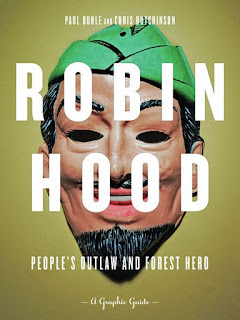A Folk Hero
Befitting the OWS Generation
Book
Review by JOHN PIETARO
ROBIN HOOD: People’s Outlaw and
Forest Hero by Paul Buhle
With
Illustrations by Chris Hutchinson, Gary Dumm and Sharon Rudahl
2011,
PM Press Oakland CA
Hot
on the heels of the latest wave of dissent comes a centuries-old radical from
deep within the English wood. Robin Hood may be overlooked as a revolutionary
due to simple over-exposure, but historian Paul Buhle, in demonstrating the
real story of Robin, let’s all of us in on the best-kept secret of the
universal Left. And the legend only begins with taking from the rich to give to
the poor.
Amidst
his powerful series of graphic histories Buhle offers this socio-biography
which, though consisting primarily of text, makes creative use of visuals. Robin
Hood straddles a niche between biography, underground comic and Pythonesque
photo manipulations. This seems about right for a hero that is at once of a
lost time and of every age. The book opens with a historic overview of the
character via quotes from early ballads and the writings of nineteenth century
socialist and poet William Morris, whose passion for social justice laid in
intriguing conflict with his Romantic yearning for an earlier, “simpler” day.
This led Morris to the same conclusion as the author of this biography: that of
the inequity found in both the Middle Ages and their own times; both make great
use of the past’s symbolism to reflect these injustices. Robin’s 1300s were a
period of bloody iron-hand rule by an elite class in towering castles. The
forests were then more dense than we can imagine and overflowing with wildlife;
the thickets closing out the sky as well as the encroaching Enlightenment.
Average citizens tried to rise above the Dark Ages as the king-as-deity enforced
poverty and starvation, refusing their desperate plea for the plentiful forest game.
Soldiers in the king’s service patrolled the forest lanes with deadly intent as
whole families fell into frightening levels of deprivation and nature’s bounty
was reserved for only the royal dinner. Something had to give.
Buhle
reminds us that the legend of this revolutionary hero grew out of the periods
of conquests as the first millennium came to be, as well as the plagues and
pestilence over the next two centuries, the brutal wars and the uprising of
1381. Corruption could not simply be found in the ruling class however, but in
the church and the manipulation of faith as a means of power was running
rampant. The peasants were subject to increased cruelty and laborers experienced
new levels of worksite injustice. In the face of the Black Plague and the
Crusades, villages deteriorated and the powers that be abandoned those in dire
need. The poor were deemed “villains” in 14th century law. It was left to a handful of men who were
pushed to the limit, who’d seen too much and whose families had gone without for
far too long. The people’s underground included skilled bowmen who served not
only to protect the commoners from harm but to brave the armies and tread on
royal hunting ground. Due to brutal reprisal, as we have seen in countless
other rebellions, the freedom fighters took on pseudonyms to protect their
identity and families. “John the Nameless” must have been a standard
revolutionary moniker as it was featured in the poem of the uprising, ‘Piers
Plowman’. An amalgam of these freedom fighters, struggling for survival and the
land they were born on, developed into the figure of Robin Hood.
Buhle
offers the reader not only vivid historical content but, true to form of the
progressive historian, a sociological view of Robin’s realization in legend and
media. It is with Robin’s adaptation in film that we see the myth grow into the
present. From All-American hero Douglas Fairbanks in silent cinema, we move to
Errol Flynn, whom Buhle reminds us developed into one of the strongest
anti-fascists and, later, a friend of Fidel Castro. Many of Flynn’s films were
of course written or directed by Hollywood lefties and he carried the icon so
well that he’d continue to be identified with the character. But the Robin Hood
figure maintained popular through the Cold War and eventual blacklistees such
as Waldo Salt, Robert Rossen and Howard Koch were at the heart of it. By the
time of the Robin Hood television series, a wealth of blacklisted writers stepped
up. But Buhle’s overview takes us through the ‘50s and ‘60s and into the
present day: the green and red struggles, contemporary labor battles and today’s
fight for social justice. Welcome to Sherwood! But everywhere is Sherwood. Robin
has occupied both the Wisconsin State House and New York’s Zuccotti Park and he’s
not vacating the premises. Even the wicked sheriffs of Madison and Manhattan cannot
keep his spirit out.
--John
Pietaro is a musician, writer and labor organizer from New York City - http://TheCulturalWorker.blogspot.com


